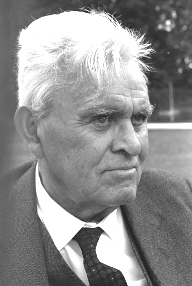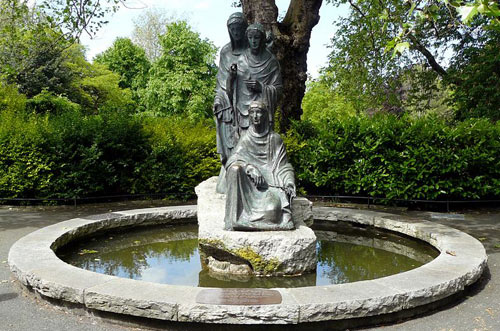
Following World War II, in 1946/47 Ireland provided £12 million pounds (today €14.14 million Euros) in aid to Germany while also welcoming some 500 traumatised children onto our shores.
Known as “Operation Shamrock” these children were taken to accommodations in Louth and Donegal, but most were taken to St. Kevin’s Hostel in Glencree, situated in the Wicklow Mountains, until a suitable host family could be located.
The first of these German children arrived here in Ireland, stepped off a passenger ferry at Dun Laoighaire Pier, Co. Dublin, on July 27th 1946. Almost one year later, by the end of June 1947, some 500 children, all aged between 3 and 15 years-of-age, were being hosted courtesy of the Irish State. Most of them had been returned back to their families three years later, however, 50 of them chose to stay for various reasons, mainly because their parents remained destitute.
The “Save the German Children Society” (SGCS) was initially founded on October 16th 1945 at a meeting in the Shelbourne Hall, Dublin. The president of the society was Dr Kathleen Farrell (née Murphy), herself a staunch IRA supporter and a paediatrician, at whose home, in Rathmines, Co. Dublin, Charlie Kerins, had been arrested in 1944, following a Garda telephone tap on her house.
Dan Breen, born in Grange, Donohill, Co. Tipperary; from 1912 a volunteer in the Irish Republican Army during the Irish War of Independence / Irish Civil War and in later years a Fianna Fáil politician, was then Treasurer of the “Save the German Children Society (SGCS)”.
Captain Dr Hermann Görtz, a convicted German spy, who had been liaising with the Irish Republican Army in Ireland and Clan na Gael in America, became Secretary of the SGCS, almost immediately following his release from Maidstone Prison, UK, in 1939.
Notes On Charlie Kerins and Hermann Görtz
Charlie Kerins
Kerry born, Cathal Ó Céirín (Charlie Kerins) was then the Chief of Staff of the Irish Republican Army, (IRA). Having spent two years on the run, as stated, he was found asleep before being arrested by the Gardaí and following a trial was convicted for the 1942 Thompson machine gun murder of Garda Detective Sergeant Denis O’Brien, at his home in Ballyboden, Co. Dublin. Kerins would later be hanged at Mountjoy Prison in Dublin, by British chief executioner Albert Pierrepoint, who was employed by the then Irish Government, led by Mr Éamon de Valera.
Hermann Görtz
In the summer of 1940, Görtz parachuted into Ireland landing in Ballivor, Co. Meath, Ireland, in an effort to gather information. He moved in with IRA leader, explosives expert and Nazi collaborator Jim (Seamus) O’Donovan. His mission was to act as a liaison officer with the IRA and enlist their assistance during a potential German occupation of Britain and possibly Ireland , latter under “Operation Green”, (German Unternehmen Grün) and the responsibility of General der Artillerie Leonhard Kaupisch.
In 1947 fearing his being handed over to British Allies in Germany, he swallowed a phial of potassium cyanide and was rushed by ambulance to Mercer’s Hospital, No.2 Stephens Street, Dublin, where he was pronounced dead.
Following his death, Dr. Goertz reposed in Deansgrange cemetery up until the night of April 26th 1974, when under the cover of darkness, some German ex-army officers exhumed his remains and re-interred them in the German War Cemetery in Glencree, Co. Wicklow and here they currently remain.
A Garda Special Branch member in attendance at SGCS meetings reported that some speakers favoured assisting Germany against anti-British sentiment. The SGCS were proposing to house Roman Catholic and Protestant children with families of the same religious denomination, but not to take Jewish children, who it feared would not ‘integrate’.
This societies membership, based on reports, now aroused the suspicion of the British and Irish authorities. Same society members made no secret of the fact that they were motived as much by anti-British and pro-German sentiment, rather than a genuine concern for the welfare of starving children.
The centenary of the Great Irish Famine was to become the motivator for the then Fianna Fáil government to assist Europe in its post-war hardship. It agreed with the British government that the SGCS was an unsuitable organisation and refused to permit any immigration under its auspices.

The operation of transporting these children it was agreed should instead be taken over by the Irish Red Cross, who had already taken Polish and French children into Ireland. Those who now came to Ireland via the newly formed “Operation Shamrock” were almost all of the Roman Catholic faith, coming from the North Rhine-Westphalia. No Jewish children were initially brought to Ireland for various reasons, mostly rooted in underlying Anti-Semitism.
Allied bombing campaigns towards the end of the war, had brought about unbelievable suffering, leaving millions of civilians starving, homeless and greatly impoverished. In all cases parents were unable to care for their children and were therefore, forced to send them abroad, thus in the hope of ensuring their health and well-being.
These children were taken to accommodations in Louth and Donegal, but most were taken to St. Kevin’s Hostel in Glencree, situated in the Wicklow Mountains, until a suitable host family could be located and interviewed.
The Irish Government however, would eventually agree to take 100 Jewish children later in 1949, from places like Belsen and Auschwitz concentration camps, with the stipulation that they be housed in Clonyn Castle, Delvin, Co. Westmeath and not allowed to be placed into foster care.
More than 280 Irish families had been located by the SGCS, offering to foster German children by December of 1945, but the British authorities, in Germany, refused to allow German refugees to travel to Ireland, if the SGCS were to be part of their planned future.
On arrival at Dun Laoighaire Pier, Co. Dublin, the first batch of children were offered oranges, cocoa and buttered bread by Red Cross nurses, when they stepped off the ship. It was reported that all the children were not familiar with the concept of orange peeling and began eating them, orange peel and all.
Children spent roughly six weeks to six months in Glencree, enjoying wholesome food and walks in the calm of the local countryside. Once screened for various infections and settled, accepted Irish families then travelled to the various named centres, to meet and pick out a child to foster.
The sculpture in the photograph shown above; a gift to the Irish people from the German Federal Republic, consists of a group of three bronze figures from Norse mythology, representing the Three Fates, Urd (past), Verdandi (present) and Skuld (future).
In Norse mythology these three female figures are known as norns, who rule the destiny of gods and men. Placed around the fountain edge are three plaques.
Each plaque states “This fountain, designed by the sculptor Josef Wackerle, is the gift of the people of the German Federal Republic to mark their gratitude for Ireland’s help after the war of 1939-45. The bronze group portrays the three legendary fates spinning and measuring the thread of man’s destiny.”
One of the three plaques is in the English language, the second is in Gaelic, and the third is in German.

Leave a Reply